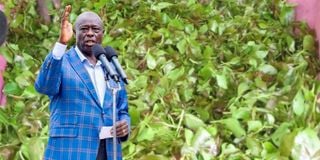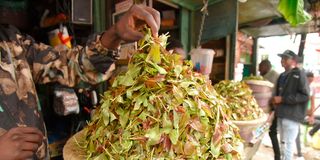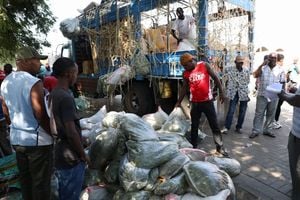
Deputy President Rigathi Gachagua.
On October 27, 1977, some 46 years ago, Jomo Kenyatta repealed the colonial-era Miraa Prohibition Act and allowed trade to thrive and consumption to commence freely. It was a political move. Today, Miraa has not only taken off as a cash crop but also has an equivalent and equally uncontrolled variant, Muguka.
It is almost 80 years since colonial Attorney General Forster Sutton published the 1945 Bill to control Miraa’s sale, cultivation and consumption. The law restricted the growing, consumption and trading to Meru District – but one had to get a license from the Provincial Commissioner. It also specified that Miraa should not be sold to those below the “Miriti” age set – whose members were recruited by the British to serve during the First World War. That might partly explain why they were allowed to chew the intoxicant, previously reserved for the elders.
While moving the Bill, Sutton said that the issuance of Miraa permits was “considered desirable” because “miraa has, from time immemorial, had a place in the tribal customs of natives of Meru District, where its use has, however, been limited to certain age grades”. As historians have noted, the traditional claims by the Meru played a part in regulating Miraa trade – more so, by limiting its consumption to a certain age.
In 1946, the Embu district was included as a territory where cultivation and consumption of Miraa were allowed – but with similar restrictions as Meru. Soon, however, Somali traders invaded the Meru and Embu regions, and a black market emerged, and the colonial government could not police it. Isiolo became one of the major markets, and “donkey-boys” would take two to three days to reach there from Meru. By the mid-1920s, after Meru was connected by road, there were new markets in Nairobi, Mombasa and the Northern Frontier Districts. By the mid-1950s, it was clear that the colonial ordinance to contain consumption had failed, and there was some renewed focus to develop Miraa's potential as an export crop. Interestingly, the law remained in the Statutes.
Asking Deputy President Rigathi Gachagua to undo such a trade is mischievous and shows how we need to use history to organize our thoughts. Muguka is one of many intoxicants on sale in Kenya, and what leaders should do is to regulate its sale and consumption. A ban will do the reverse and create a vast black market, the way it did for Isiolo during the colonial period.
Miraa Prohibition Act
There are various surviving narratives on why Kenyatta lifted the ban: “After Independence,” Kiraitu Murungi once alleged in Parliament, “a delegation from Meru (went) to Gatundu and (took) miraa to late President Kenyatta. After he had tasted, he ordered the Miraa Prohibition Act to be repealed”. That may be part of the story. When each region in Kenya was looking for a cash crop, the Miraa trade was an easier route to silence the Meru region, and parts of Embu were agitating against the criminalisation of trees. Once, Dennis Akumu, who claimed to have been privy to the Miraa debate in Gatundu, claimed that Kenyatta said that even “elders used to smoke bhang, and there was no problem”. He said: “Problems arose when youth and university students took it up.”
Kenyatta, and as colonial governors found out, controlling the growing and consumption of Miraa and other varieties took time and effort. Colonial governors passed the law but were poor in policing. Kenyatta did not want to sustain a colonial law that restricted a crop that would bring in much-needed dollars.

Muguka traders display their wares in Nakuru City
As noted above, to throw the entire debate to Gachagua's doorstep and to ask him to include Muguka in his fight against drug abuse and alcoholism in Central Kenya is not being done in good faith. While there is a need to widen the campaign against the vice nationwide, that is not Gachagua's duty. But again, those who have set him up are grinning as they watch him in a catch-22 position. Damned if he does, and damned if he doesn't. Though there are valid concerns about the medical and social harms attributed to Muguka, which happens to grow in Gachagua's Mt Kenya backyard, the mischief behind the debate is mind-boggling.
During the UDA campaigns, its leaders publicly chewed the intoxicant – their Christian faith notwithstanding – and promised to look for new markets. Today, they are yelling at Gachagua to spearhead the ban, and they have mischievously handed him Muguka as the political noose or as his Waterloo. The man from Mathira never saw it coming.
Intoxicants
Gachagua might need a combination of political strategists like Karl Love, James Carville and Alastair Campbell to create a winning narrative. The Coast region – and I saw Minority Leader Opiyo Wandayi enter the fray – recently banned the sale of Muguka in their counties and ignored President William Ruto’s intervention. How Gachagua is expected to fight alcoholism in the Mt Kenya region – he says the brews are done by ‘outsiders’ – and ignore the Miraa and Muguka as equal intoxicants is beyond my imagination.
On this one, he must run with the hare and hunt with the hounds. To start with, Miraa and Muguka have transcended beyond the Mt Kenya county borders, and the local governors have the hogwash argument that “Muguka is not a drug”, as Embu Governor Cecily Mbarire and House Speaker Justin Muturi recently said. Such an argument adds no value.
One of the earliest literature I have come across on Miraa (and Muguka as well) is William Chanler's 1896 book, Through Jungle and Desert: Travels in East Africa, in which he recounts his encounter with “natives of Jombeni” who are “very fond of chewing the leaves and tender shoots of a tree” who are “very fond of chewing the leaves and tender shoots of a tree here called Miraa”.
Chanler was no doubt referring to Nyambene Hills, the home of Miraa kingpins. Chanler was given a bunch and reported his experience: “I found that a very small quantity of the bark was sufficient to produce in me a considerable elevation of spirits, but some hours after eating, I perceived a distinct feeling of lassitude. The young men among the natives are not allowed to eat it, the reason assigned to this restriction is that if the young men were allowed freely to indulge in this plant, they would be apt to remain awake at night and be tempted, under cover of darkness, to gratify desired which the light of day forces them to curb.”
Chanler’s book reveals that the youth were restricted from consuming Miraa and its variants – a tradition that has collapsed. The AG is asking Kenyans not to vilify Muguka before any scientific study is done. Mr AG, “The proof of the pudding is in the eating.” Besides its side effects, the Miraa debate is lost in numbers because of the millions of shillings that it generates in the Mount Kenya region. It has also become a political crop, and any attempt to ban it or restrict its market is met with threats from the subalterns and the peddlers.
When a call for the ban was made in Parliament in the mid-90s, then Kisauni MP, Prof Rashid Mzee, told Parliament that miraa and its various varieties contain "lots of chemicals" and was wasting people's time since “a person will sit down six to eight hours to consume enough miraa to reach the peak of stimulation”. He also argued that it was “very expensive”. During the debate, Imenti North MP Kiraitu Kiraitu claimed that the Miraa trade had created a strong bond between the Somalis and the Meru, but Prof Mzee retorted that it was the relationship between a victim and a predator.
Finally, the motion urging the government to consider controlling the selling and consumption of Miraa was passed. No Bill has ever been drafted to actualise that thinking.
Therefore, this is not the first time that the crop has faced challenges in Kenya – only that it has been thrown to the doorstep of Gachagua – the way Mwai Kibaki threw Mau Forest rehabilitation to Raila Odinga leading to his fallout with the Kalenjin community. In Nyambene, miraa and other varieties supersede tea and coffee as an income generator, and Gachagua will be politically naïve to swallow the hook.
The anti-Gachagua wing within the United Democratic Alliance (UDA) and those who would like to lock him out of the William Ruto succession are keenly watching how he sails through this challenge – for both Miraa and Muguka are, to an extent, the economic fortunes of the larger Meru districts, and parts of Embu. Will he?
[email protected] @johnkamau1












